|


 |
| CASE REPORT |
|
| Year : 2011 | Volume
: 3
| Issue : 2 | Page : 94-96 |
|
|
Primary cutaneous aspergillosis in an immunocompetent patient
Chubado Tahir1, Musa Garbati2, Haruna A Nggada3, Edith H Terna Yawe1, Auwal M Abubakar4
1 Department of Surgery, Plastic and Reconstructive Surgery Unit, College of Medical Sciences, University of Maiduguri, University of Maiduguri Teaching Hospital, Maiduguri, Nigeria
2 Department of Medicine, Infectious Disease Unit, College of Medical Sciences, University of Maiduguri, University of Maiduguri Teaching Hospital, Maiduguri, Nigeria
3 Department of Histopathology, College of Medical Sciences, University of Maiduguri, University of Maiduguri Teaching Hospital, Maiduguri, Nigeria
4 Department of Surgery, Pediatric Surgery Unit, College of Medical Sciences, University of Maiduguri, University of Maiduguri Teaching Hospital, Maiduguri, Nigeria
| Date of Web Publication | 11-Feb-2012 |
Correspondence Address:
Chubado Tahir
Department of Surgery, University of Maiduguri Teaching Hospital, P. O. Box 4088, Maiduguri, Maiduguri
Nigeria
 Source of Support: None, Conflict of Interest: None  | 2 |
DOI: 10.4103/2006-8808.92802

 Abstract Abstract | | |
We present a 32-year-old woman with primary cutaneous aspergillosis and an apparently normal immune status. She is a dietitian who carried out research on Aspergillus contamination of palm oil over a six-month period, during which she apparently shaved her axillae and perineum using a safety razor blade. She presented with nodular lesions, which became extensive ulcers after an attempt at incision and drainage. Diagnosis was based on culture and histology. The patient was treated with itraconazole 200 mg twice a day, with surgical excision and a rhomboid flap cover of the axillae. She has remained disease-free five years after discharge. This highlights the likely benefits of a combination of surgical excision and drug therapy, in achieving a cure in this patient. Keywords: Aspergillus, cutaneous, immunocompetent, surgery
How to cite this article:
Tahir C, Garbati M, Nggada HA, Terna Yawe EH, Abubakar AM. Primary cutaneous aspergillosis in an immunocompetent patient. J Surg Tech Case Report 2011;3:94-6 |
How to cite this URL:
Tahir C, Garbati M, Nggada HA, Terna Yawe EH, Abubakar AM. Primary cutaneous aspergillosis in an immunocompetent patient. J Surg Tech Case Report [serial online] 2011 [cited 2016 Jun 12];3:94-6. Available from: http://www.jstcr.org/text.asp?2011/3/2/94/92802 |
 Introduction Introduction | |  |
Aspergillus species is the second most common cause of opportunistic fungal infection in humans after candida albicans. It causes severe infections in immunocompromised patients resulting in high mortality, especially in neonates. [1],[2],[3],[4] The usual sites of infections are the lungs, central nervous system (CNS), and sinuses, however, the rare cutaneous infection is usually associated with immunodeficiency. Primary cutaneous infection, especially in immunocompetent patients, is extremely rare, but an increase in prevalence has been noted in the last 20 years. The predisposing factors noted in addition to immunodeficiency include, traumatic inoculation, occlusive dressing for an indwelling catheter, burns, aerosolization of fungi during the renovation of building, and prematurity in neonates. [1],[2],[3],[4]
 Case Report Case Report | |  |
A 32-year-old female dietitian was referred to the Plastic Surgery Unit with multiple axillary and perineal ulcers and sinuses, following incision and drainage of slowly growing nodular lesions over a one-year period. There was associated severe weight loss and constipation due to pain. However, there was no history of fever, cough, ingestion of steroids or any immunosuppressant drugs. A year before the onset of symptoms, she conducted a research on aspergillus contamination of palm oil over a six-month period and admitted to shaving her axillae and pubic region with a safety razor several times within that period. Physical examination revealed multiple ulcers in the axillae and multiple ulcers and few discharging sinuses in the perineum. The vaginal and rectal examinations were done under general anesthesia and revealed no communication with the vagina or rectum. [Figure 1]a and b. There was no significant finding on systemic examination. The biopsy specimens were taken for culture and histopathology. The results revealed a significant growth of aspergillus species and the histological features confirmed invasive aspergillosis. Other investigations, including a chest x-ray, abdominal ultrasound scan, fasting blood sugar, and Mantoux test were all unremarkable. Human immunodeficiency virus (HIV) screening was negative, PCV was 26%, and ESR 150 mm / hour. A diagnosis of primary cutaneous aspergillus infection was made. She was commenced on itraconazole 200 mg b.i.d and daily wound dressing with pure honey. Two weeks after admission, she had wound excision of the right axilla with rhomboid flap cover. Three weeks later, the left axilla and perineum were done. Immediately after surgery, she had weakness of the left upper limb, which recovered fully with physiotherapy and her wound healed completely [Figure 2]a and b. She was discharged and has remained disease-free, five years after discharge. | Figure 1: a: Right axillary cutaneous aspergillosis, preoperative
Figure 1: b: Cutaneous aspergillosis of the perineum of the same patient, preoperative
Click here to view |
 | Figure 2: a: Same patient after surgical excision and rhomboid flap cover
Figure 2: b: Perineum after surgical excision and direct closure
Click here to view |
 Discussion Discussion | |  |
Primary Cutaneous Aspergillosis (PCA) is a rare disease seen in immunosuppressed patients; it is extremely rare in immunocompetent patients and poses a diagnostic challenge. [1] Cutaneous aspergillosis can be either primary or secondary, which results from disseminated aspergillosis. Primary cutaneous lesions result from direct inoculation of the aspergillus species from trauma, especially in patients on catheter, trauma from an arm board, burns, contaminated dressings, and cases have been reported in the neonatal Intensive Care Units (ICU) from aerosolization of fungi during building renovation. Other predisposing factors include prematurity in neonates, use of steroids and other immunosuppressive drugs, and maceration of skin due to exposure to a warm moist environment for prolonged periods. After Candida albicans, the aspergillus species is the most common cause of human opportunistic fungal infection. The organism is abundant in the environment, the common sources are decaying vegetation, stored grains, and soil. [1],[3],[4],[5],[6],[7]
Our patient most probably contracted the infection from contaminated palm oil on which she was conducting her research and got inoculated after shaving her axillae and perineum with razor blades several times within the period of that research. The practice of removal of axillary hair with a safety razor is said to increase susceptibility to hidradenitis suppurativa, which is an inflammatory disease of the skin and subcutaneous tissue that occurs in the apocritic gland-bearing area in the axilla, perineum, perianal region, mons pubis, groin, and scrotum. [8] Although over 300 species of aspergillus exist, over 90% of human infection is by Aspergillus fumigatus, typically causing systemic infection involving the lungs, blood, and sinuses; primary skin infection is usually caused by Aspergillus flavus, terreus, niger and utus. [3],[4],[5],[9]
Primary Cutaneous Aspergillosis may present as erythematous, indurated macules, papules, Plaque or hemorrhagic bullae, which may progress to necrotic ulcers that are covered by black eschar. Nodules and pustular lesions although rare might also occur. [1],[3],[5] Our patient presented with nodules, which ulcerated after attempted incision and drainage in a referral clinic. There have been cases reported in the axillae and perineum of neonates, and in these patients the lesions typically originate as erythematous patches or Plaque that develop into pustules and eventually ulcerate to form necrotic eschars. [6],[9]
Treatment for aspergillosis is systemic drug therapy with antifungal drugs like amphotericin B and Itraconazole. Treatment of primary cutaneous fungal infection is controversial, both medical and surgical modalities have been undertaken. [10] However, in the cutaneous disease, surgical excision alone and in some cases in combination with drug therapy has been found to be curative. [3],[5],[9],[10],[11] In our patients due to the extent of the lesions, a combination of drug therapy (Itraconazole), surgical excision, and rhomboid flap cover in the axillae was probably the only viable treatment option. Making an early diagnosis of PCA, especially in an immunocompetent patient is a clinical challenge, however, a combination of appropriate treatment with new antifungal drugs and careful considerations of adjunctive surgical therapy should improve the outcome in such patients. [9],[10] This is aptly illuminated in our patient.
 Conclusion Conclusion | |  |
Early diagnosis, a combination of surgical excision and systemic drug therapy with anti-fungal drugs will improve the outcome in patients with primary cutaneous aspergillosis, by reducing the chances of systemic dissemination and achieving a cure.
 References References | |  |
| 1. | Ajith C, Dogra S, Radotra BD, Chakrabarti A, Kumar B. Primary Cutaneous Aspergillosis in an immunocompetent individual. J Eur Acad Dermatol Ven 2006;20:738-9. 
|
| 2. | Anderssen J. Nygaard EA, Stordal K. Primary Cutaneous Aspergillosis (PCA): A case Report. Acta Paediatr 2005;94:761-2. 
|
| 3. | Ozer B, Kalaci A, Duran N, Dogramaci Y, Yanay AN; Cutaneous infection caused by aspergillus terreus.: Case report. J Med Micro 2009;58:968-70. 
|
| 4. | Granstein RD, First LR, Sober AJ. Primary cutaneous aspergillosis in premature neonates. Br J Dermatol 1980;103:681-4. 
[PUBMED] |
| 5. | Romano C, Miracco C. Primary Cutaneous Aspergillosis in an immune-competent patient. Mycoses 2003;46:56-9. 
[PUBMED] |
| 6. | Woodruff CA, Herbert AA. Neonatal primary cutaneous aspergillosis: Case report and review of the literature. Paediatric Dermatol 2002;19:439-44. 
|
| 7. | Prasad PV, Babu A, Kaviarasan PK, Anadhi C, Viswanathan P. Primary cutaneous aspergillosis. Indian J Dermatol Verner Leprol 2005;71:133-4. 
|
| 8. | Edlich RF, Winters KL, Britt LD, Long WD, Gubler KD, Drake DB. Difficult wounds: An update. J Long Term Eff Med Implants 2005;15:289-302. 
|
| 9. | Paterson DL. New clinical presentations of invasive Aspergillosis in non-conventional hosts. Eur J Clin Microbiol Infect Dis 2004;10:24-30. 
|
| 10. | Benedict LM, Kusne S, Torre-Cisneros J, Hunt SJ. Primary cutaneous fungal infection after Solid organ transplantation: Report of five cases and review. Clin Infect Dis 1992;15:17-21. 
[PUBMED] [FULLTEXT] |
| 11. | Loria KM, Salinger MH, Frohlich TG, Gendelman MD, Cook FV, Arentzen CE. Primary cutaneous aspergillosis in a heart transplant recipient treated with surgical excision and oral itraconazole. J Heart Lung Transplant 1992;11:156-9. 
[PUBMED] |
[Figure 1], [Figure 2]
| This article has been cited by | | 1 |
Morphological Findings of Deep Cutaneous Fungal Infections |
|
| Angel Fernandez-Flores,Marcela Saeb-Lima,Roberto Arenas-Guzman | | The American Journal of Dermatopathology. 2014; 36(7): 531 | | [Pubmed] | [DOI] | | | 2 |
Role of carbonic anhydrases in pathogenic micro-organisms: a focus on Aspergillus fumigatus |
|
| J. M. Tobal,M. E. d. S. F. Balieiro | | Journal of Medical Microbiology. 2014; 63(Pt_1): 15 | | [Pubmed] | [DOI] | | | 3 |
Primary cutaneous aspergillosis due to Aspergillus tamarii in an immunocompetent host |
|
| Sharma, S., Yenigalla, B.M., Naidu, S.K., Pidakala, P. | | BMJ Case Reports. 2013; | | [Pubmed] | |
|




 |
 |
|